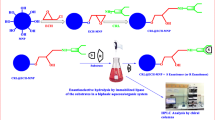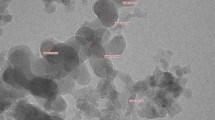Abstract
Aim
Due to lipases’ regio-selectivity and ability to catalyze different reactions such as hydrolysis, esterification, and transesterification, the enzyme is attractive in biotransformation technology. Besides, another technology, namely enzyme immobilization, has attracted scientists/technologists’ attention to employ immobilized lipase in such a field. Thus lipase of Candida rugosa was immobilized onto silica nanoparticles through adsorption. Furthermore, the immobilized biocatalyst was characterized and used to esterify ibuprofen enantioselectively.
Methods
To characterize immobilized lipase onto silica nanoparticles scanning electron microscopy (SEM) and dynamic light scattering (DLS) were used.
Results
The catalytic properties of both immobilized and free lipases such as optima pH and temperature were not different. According to the results, the immobilized lipase on silica nanoparticles showed 45% and 96% conversion (C) and enantioselectivity (ees), respectively. In comparison to free lipase, the immobilized enzyme came with better catalytic activity.
Conclusion
Silica nanoparticles as one of the most promising materials for the immobilization of lipase in enantioselective esterification of ibuprofen, were introduced in this work.
Graphical abstract









Similar content being viewed by others
References
Xie Y-C, Liu H-Z, Chen J-Y. Candida rugosa lipase catalyzed esterification of racemic ibuprofen with butanol: racemization of R-ibuprofen and chemical hydrolysis of S-ester formed. Biotechnology Letters. 1998;20:455–8.
Shoda SI, Uyama H, Kadokawa JI, Kimura S, Kobayashi S. Enzymes as green catalysts for precision macromolecular synthesis. Chemical Reviews. 2016;116:2307–413.
Sie Yon L, Gonawan FN, Kamaruddin AH, Uzir MH. Enzymatic deracemization of (R, S)-ibuprofen ester via lipase-catalyzed membrane reactor. Ind Eng Chem Res. 2013;52:9441–53.
Muralidhar RV, Marchant R, Nigam P. Lipases in racemic resolutions. Journal of Chemical Technology & Biotechnology: International Research in Process, Environmental & Clean Technology. 2001;76:3–8.
Bayramoğlu G, Arıca MY. Preparation of poly (glycidylmethacrylate–methylmethacrylate) magnetic beads: application in lipase immobilization. J Mol Catal B Enzym. 2008;55:76–83.
Yahya AR, Anderson WA, Moo-Young M. Ester synthesis in lipase-catalyzed reactions. Enzyme and Microbial Technology. 1998;23:438–50.
Carvalho PDO, Contesini FJ, Ikegaki M. Enzymatic resolution of (R, S)-ibuprofen and (R, S)-ketoprofen by microbial lipases from native and commercial sources. Brazilian Journal of Microbiology. 2006;37:329–37.
Ghanem A. Direct enantioselective HPLC monitoring of lipase-catalyzed kinetic resolution of flurbiprofen. Chirality. 2010;22:597–603.
Liu Y, Wang F, Tan T. Effects of alcohol and solvent on the performance of lipase from Candida sp. in enantioselective esterification of racemic ibuprofen. J Mol Catal B Enzym. 2009;56:126–30.
Burney PR, Pfaendtner J. Structural and dynamic features of Candida rugosa lipase 1 in water, octane, toluene, and ionic liquids BMIM-PF6 and BMIM-NO3. J Phys Chem B. 2013;117:2662–70.
Sánchez A, Valero F, Lafuente J, Solà C. Highly enantioselective esterification of racemic ibuprofen in a packed bed reactor using immobilised Rhizomucor miehei lipase. Enzyme and Microbial Technology. 2000;27:157–66.
Kato K, Gong Y, Saito T, Kimoto H. Efficient preparation of optically active ketoprofen by Mucor javanicus lipase immobilized on an inorganic support. J Biosci Bioeng. 2000;90:332–4.
Morrone R, D’Antona N, Lambusta D, Nicolosi G. Biocatalyzed irreversible esterification in the preparation of S-naproxen. Journal of molecular catalysis B: Enzymatic. 2010;65:49–51.
Pinnen F, Sozio P, Cacciatore I, Cornacchia C, Mollica A, et al. Ibuprofen and glutathione conjugate as a potential therapeutic agent for treating Alzheimer's disease. Archiv der Pharmazie. 2011;344:139–48.
Madhav MV, Ching CB. Study on the enzymatic hydrolysis of racemic methyl ibuprofen ester. Journal of Chemical Technology & Biotechnology. 2001;76:941–8.
Zhao X-G, Wei D-Z, Song Q-X. A facile enzymatic process for the preparation of ibuprofen ester prodrug in organic media. Journal of Molecular Catalysis B: Enzymatic. 2005;36:47–53.
Chen JC, Tsai SW. Enantioselective synthesis of (S)-ibuprofen ester prodrug in cyclohexane by Candida rugosa lipase immobilized on Accurel MP1000. Biotechnology progress. 2000;16:986–92.
Long WS, Kow PC, Kamaruddin AH, Bhatia S. Comparison of kinetic resolution between two racemic ibuprofen esters in an enzymic membrane reactor. Process Biochemistry. 2005;40:2417–25.
Tsai SW, Lin JJ, Chang CS, Chen JP. Enzymatic synthesis of (S)-ibuprofen ester prodrug from racemic ibuprofen by lipase in organic solvents. Biotechnology Progress. 1997;13:82–8.
Mazaleuskaya LL, Theken KN, Gong L, Thorn CF, FitzGerald GA, Altman RB, et al. PharmGKB summary: ibuprofen pathways. Pharmacogenet Genomics. 2015;25(2):96–106.
Fazlena H, Kamaruddin A, Zulkali M. Dynamic kinetic resolution: alternative approach in optimizing S-ibuprofen production. Bioprocess and Biosystems Engineering. 2006;28:227–33.
Foresti ML, Galle M, Ferreira ML, Briand LE. Enantioselective esterification of ibuprofen with ethanol as reactant and solvent catalyzed by immobilized lipase: experimental and molecular modeling aspects. Journal of Chemical Technology & Biotechnology. 2009;84:1461–73.
Cao S-L, Huang Y-M, Li X-H, et al. Preparation and characterization of immobilized lipase from Pseudomonas cepacia onto magnetic cellulose nanocrystals. Scientific reports. 2016;6:20420.
da Silva VCF, Contesini FJ, de Oliveira Carvalho P. Enantioselective behavior of lipases from Aspergillus niger immobilized in different supports. Journal of Industrial Microbiology & Biotechnology. 2009;36:949–54.
Liu X, Guan Y, Shen R, Liu H. Immobilization of lipase onto micron-size magnetic beads. J Chromatogr B. 2005;822:91–7.
Jiang Y, Guo C, Xia H, Mahmood I, Liu C, Liu H. Magnetic nanoparticles supported ionic liquids for lipase immobilization: Enzyme activity in catalyzing esterification. Journal of Molecular Catalysis B: Enzymatic. 2009;58:103–9.
Bradford MM. A rapid and sensitive method for the quantitation of microgram quantities of protein utilizing the principle of protein-dye binding. Analytical Biochemistry. 1976;72:248–54.
Kruger NJ. The Bradford method for protein quantitation, The protein protocols handbook, Springer. 2009; pp. 17–24.
Guo J, Chen C-P, Wang S-G, Huang X-J. A convenient test for lipase activity in aqueous-based solutions. Enzyme Microb Technol. 2015;71:8–12.
López N, Pernas MA, Pastrana LM, Sánchez A, Valero F, Rúa ML. Reactivity of pure Candida rugosa lipase isoenzymes (Lip1, Lip2, and Lip3) in aqueous and organic media. Influence of the isoenzymatic profile on the lipase performance in organic media. Biotechnology Progress. 2004;20:65–73.
Serra E, Mayoral Á, Sakamoto Y, Blanco RM, Díaz I. Immobilization of lipase in ordered mesoporous materials: Effect of textural and structural parameters. Microporous and Mesoporous Materials. 2008;114:201–13.
Hermanova S, Zarevucka M, Bousa D, Pumera M, Sofer Z. Graphene oxide immobilized enzymes show high thermal and solvent stability. Nanoscale. 2015;7:5852–8.
Sagiroglu A, Klinnc A, Telefoncu A. Preparation and properties of lipases immobilized on different supports. Artificial cells and blood substitute. Biotechnology. 2004;32(4):625–36.
Dasilva VF, Contesini FJ, de O. Carvalho P. Characterization and catalytic activity of free and immobilized lipase from Aspergilus niger :a comparitive study. J. Braz. Chem. Soc. 2008;1998:1468–74.
Wu SH, Guo ZW, Sih CJ. Enhancing the enantioselectivity of Candida lipase-catalyzed ester hydrolysis via noncovalent enzyme modification. Journal of American Chemical Society. 1990;112:1990–5.
Mustranta A. Use of lipases in the resolution of racemic ibuprofen. Applied Microbiology and Biotechnology. 1992;38:61–6.
Goto M, Kamiya N, Miyata M, Nakashio F. Enzymatic esterification by surfactant-coated lipase in organic media. Biotechnology Progress. 1994;10:263–8.
Hongwei Y, Jinchuan W, Chi Bun C. Kinetic resolution of ibuprofen catalyzed by Candida rugosa lipase in ionic liquids. Chirality. 2005;17:16–21.
Li K, Wang J, He Y, Cui G, Abdulrazaq MA, Yan Y. Enhancing enzyme activity and enantioselectivity of Burkholderia cepacia lipase via immobilization on melamine-glutaraldehyde dendrimer modified magnetic nanoparticles. Chemical Engineering Journal. 2018;351:258–68.
Swetha E, Vijitha C, Veeresham C. Enantioselective conversion of racemic Sotalol to R(−)-Sotalol by lipase AP6. Indian Journal of Pharmaceutical Sciences. 2018;80(4):676–85.
Xu L, Cui G, Ke C, Fan Y, Yan Y. Immobilized Burkholderia cepacia Lipase on pH-Responsive Pullulan Derivatives with Improved Enantioselectivity in Chiral Resolution. Catalysts. 2018;8(1):13.
Gilani SL, Najafpour GD, Heydarzadeh HD, Moghadamnia A. Enantioselective synthesis of (S)-naproxen using immobilizedlipase on chitosan beads. Chirality. 2017;29:304–14.
Acknowledgments
The authors acknowledge the technical support of the Department of Biochemistry, Tehran University of Medical Sciences.
Author information
Authors and Affiliations
Corresponding author
Ethics declarations
Conflict of interest
The authors declare no conflict of interest.
Additional information
Publisher’s note
Springer Nature remains neutral with regard to jurisdictional claims in published maps and institutional affiliations.
Rights and permissions
About this article
Cite this article
Ghofrani, S., Allameh, A., Yaghmaei, P. et al. Immobilization of Candida rugosa lipase for resolution of racimic ibuprofen. DARU J Pharm Sci 29, 117–123 (2021). https://doi.org/10.1007/s40199-021-00388-7
Received:
Accepted:
Published:
Issue Date:
DOI: https://doi.org/10.1007/s40199-021-00388-7




